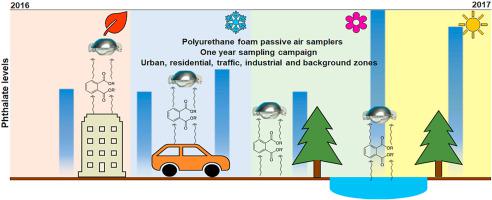Atmospheric Pollution Research ( IF 3.9 ) Pub Date : 2020-10-29 , DOI: 10.1016/j.apr.2020.10.019 Tijana Vasiljevic , Ky Su , Tom Harner

|
Measurements of the outdoor air concentrations of phthalates (PHTs) using passive sampling media (polyurethane foam (PUF) disks) were conducted at 8 different sites across the Greater Toronto Area (GTA) during 2016–2017. Highest PHT levels were obtained at sites characterized by high levels of urban and traffic activity. The PHT profile was mainly dominated by bis(2-ethylhexyl) phthalate (DEHP), whose median air concentration across the examined sites was MDEHP = 1200 pg/m3. It was discovered that PHT levels had a strong correlation with the ambient temperature. Warmer months appeared to contribute to greater emission of PHTs at most sites. Clausius Clapeyron (CC) plots were used to investigate the presence of temperature dependent processes governing PHT emissions, such as secondary volatilization from environmental surfaces. Enthalpies of surface-air exchange calculated from CC plots were compared to respective enthalpies of vaporization for each PHT. Those values were used to examine importance of localized water-air and land-air exchanges on atmospheric levels of PHTs. The data suggested that secondary volatilizations are relevant PHT contributors and appear to depend on sampling site and PHT type. Enthalpies associated with Henry's law constant were also evaluated, providing evidence of secondary volatilization from water bodies. This work is part of an on-going study which already evaluated levels of organophosphate esters (OPEs), polybrominated diphenyl ethers (PBDEs) and polycyclic aromatic compounds (PACs) at the same sites. Ultimately, the variability in ambient concentrations of PHTs in the GTA are believed to be due to a combination of both primary and secondary sources.
中文翻译:

首先看一下大多伦多地区不同城市地区的邻苯二甲酸盐的大气浓度和时间趋势
在2016-2017年期间,在大多伦多地区(GTA)的8个不同地点进行了使用被动采样介质(聚氨酯泡沫(PUF)圆盘)的邻苯二甲酸盐(PHT)室外空气浓度测量。在具有较高城市和交通活动水平的地点获得了最高的PHT水平。PHT谱主要由邻苯二甲酸二(2-乙基己基)酯(DEHP)占据主导地位,其整个检测部位的中值空气浓度为MDEHP = 1200 pg / m 3。发现PHT水平与环境温度有很强的相关性。温暖的月份似乎在大多数地点导致了更多的PHT排放。Clausius Clapeyron(CC)图用于调查控制PHT排放的温度相关过程的存在,例如环境表面的二次挥发。比较从CC图计算出的地表空气交换焓与每种PHT的各自蒸发焓。这些值被用来检验局部水-空气和陆-空气交换对小灵通大气水平的重要性。数据表明,二次挥发是相关的PHT贡献者,并且似乎取决于采样地点和PHT类型。还评估了与亨利定律常数相关的焓,提供水体二次挥发的证据。这项工作是正在进行的研究的一部分,该研究已经评估了同一地点的有机磷酸酯(OPE),多溴二苯醚(PBDEs)和多环芳族化合物(PAC)的水平。归根结底,人们认为GTA中PHT的环境浓度变化是由于主要来源和次要来源的结合。











































 京公网安备 11010802027423号
京公网安备 11010802027423号